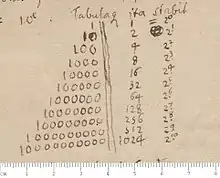1024 (number)
1024 is the natural number following 1023 and preceding 1025.
| ||||
|---|---|---|---|---|
← 0 [[{{#expr:{{{1}}}*{{{factor}}}*1000}} (number)|{{#ifeq:{{{1}}}|10|→|{{#expr:{{{1}}}*{{{factor}}}}}k}}]] [[{{#expr:{{{1}}}*{{{factor}}}*1000}} (number)|{{#ifeq:{{{1}}}|10|→|{{#expr:{{{1}}}*{{{factor}}}}}k}}]] [[{{#expr:{{{1}}}*{{{factor}}}*1000}} (number)|{{#ifeq:{{{1}}}|10|→|{{#expr:{{{1}}}*{{{factor}}}}}k}}]] [[{{#expr:{{{1}}}*{{{factor}}}*1000}} (number)|{{#ifeq:{{{1}}}|10|→|{{#expr:{{{1}}}*{{{factor}}}}}k}}]] [[{{#expr:{{{1}}}*{{{factor}}}*1000}} (number)|{{#ifeq:{{{1}}}|10|→|{{#expr:{{{1}}}*{{{factor}}}}}k}}]] [[{{#expr:{{{1}}}*{{{factor}}}*1000}} (number)|{{#ifeq:{{{1}}}|10|→|{{#expr:{{{1}}}*{{{factor}}}}}k}}]] [[{{#expr:{{{1}}}*{{{factor}}}*1000}} (number)|{{#ifeq:{{{1}}}|10|→|{{#expr:{{{1}}}*{{{factor}}}}}k}}]] [[{{#expr:{{{1}}}*{{{factor}}}*1000}} (number)|{{#ifeq:{{{1}}}|10|→|{{#expr:{{{1}}}*{{{factor}}}}}k}}]] [[{{#expr:{{{1}}}*{{{factor}}}*1000}} (number)|{{#ifeq:{{{1}}}|10|→|{{#expr:{{{1}}}*{{{factor}}}}}k}}]] [[{{#expr:{{{1}}}*{{{factor}}}*1000}} (number)|{{#ifeq:{{{1}}}|10|→|{{#expr:{{{1}}}*{{{factor}}}}}k}}]] | ||||
| Cardinal | one thousand twenty-four | |||
| Ordinal | 1024th (one thousand twenty-fourth) | |||
| Factorization | 210 | |||
| Divisors | 1, 2, 4, 8, 16, 32, 64, 128, 256, 512, 1024 | |||
| Greek numeral | ,ΑΚΔ´ | |||
| Roman numeral | MXXIV | |||
| Binary | 100000000002 | |||
| Ternary | 11012213 | |||
| Octal | 20008 | |||
| Duodecimal | 71412 | |||
| Hexadecimal | 40016 | |||

1024 is a power of two: 210 (2 to the tenth power).[1] It is the nearest power of two from decimal 1000 and senary 100006 (decimal 1296).
1024 is the smallest number with exactly 11 divisors (but note that there are smaller numbers with more than 11 divisors; e.g., 60 has 12 divisors) (sequence A005179 in the OEIS).
Approximation to 1000
The neat coincidence that 210 is nearly equal to 103 provides the basis of a technique of estimating larger powers of 2 in decimal notation. Using 210a+b ≈ 2b103a is fairly accurate for exponents up to about 100. For exponents up to 300, 3a continues to be a good estimate of the number of digits.
For example, 253 ≈ 8×1015. The actual value is closer to 9×1015.
In the case of larger exponents, the relationship becomes increasingly inaccurate, with errors exceeding an order of magnitude for a ≥ 97. For example:
In measuring bytes, 1024 is often used in place of 1000 as the quotients of the units byte, kilobyte, megabyte, etc. In 1999, the IEC coined the term kibibyte for multiples of 1024, with kilobyte being used for multiples of 1000.
Special use in computers
In binary notation, 1024 is represented as 10000000000, making it a simple round number occurring frequently in computer applications.
1024 is the maximum number of computer memory addresses that can be referenced with ten binary switches. This is the origin of the organization of computer memory into 1024-byte chunks or kibibytes.
In the Rich Text Format (RTF), language code 1024 indicates the text is not in any language and should be skipped over when proofing. Most used languages codes in RTF are integers slightly over 1024.
1024×768 pixels and 1280×1024 pixels are common standards of display resolution.
See also
- Powers of 1024
References
- Bryan Bunch, The Kingdom of Infinite Number. New York: W. H. Freeman & Company (2000): 170
